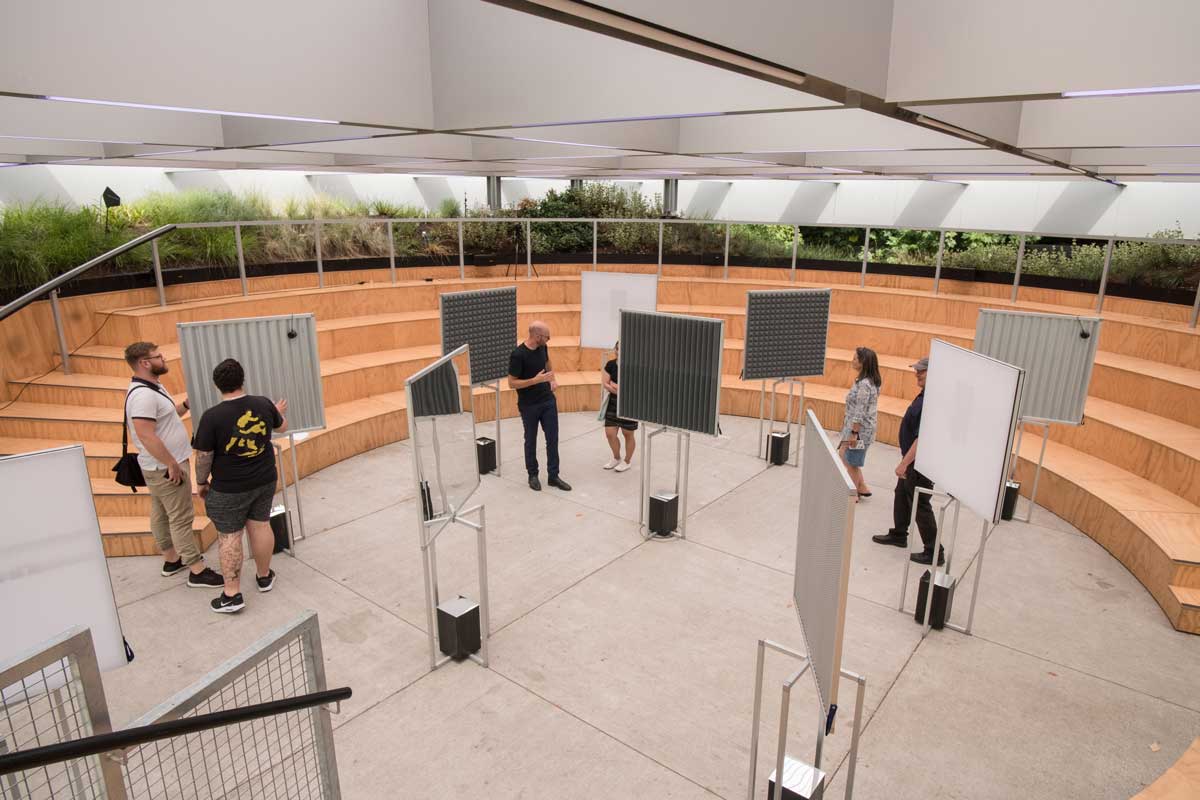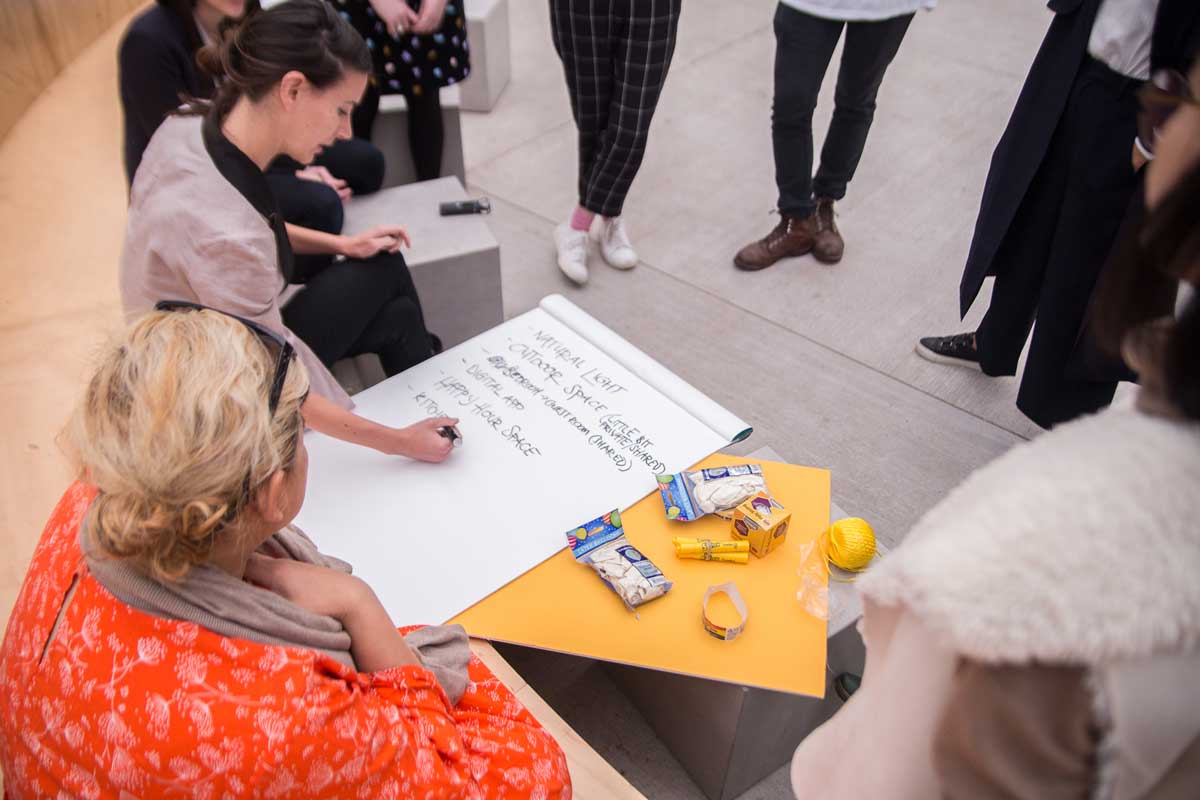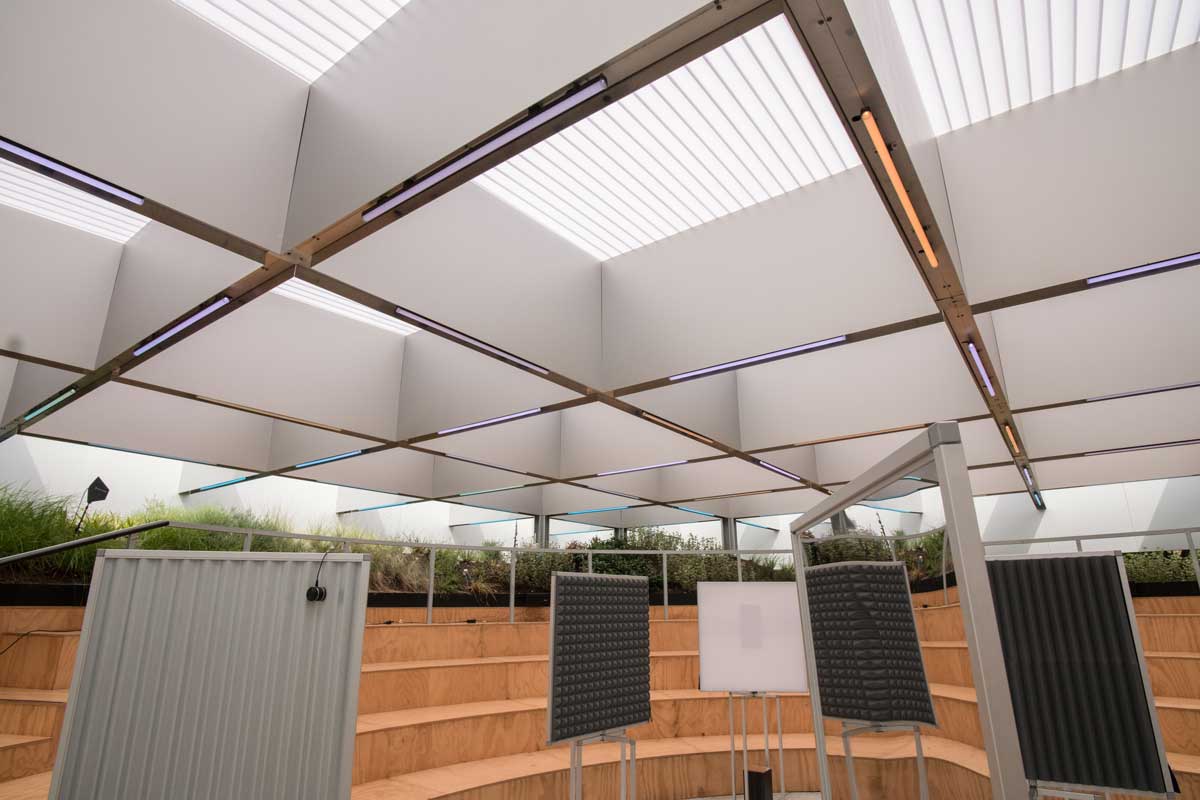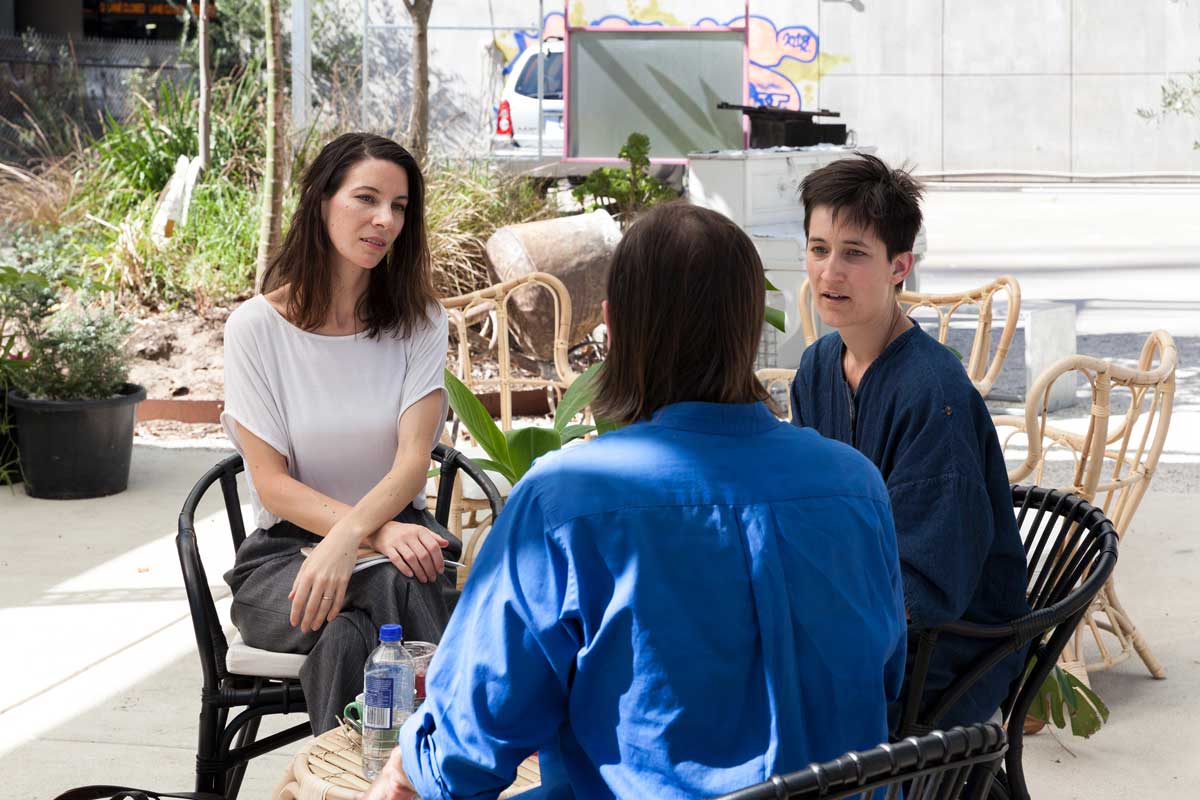Imagining Ageing with Sibling × Arup
The city of the future will be much older than anything we have experienced. What will it mean to maintain liveability when a quarter of the population is of retirement age? Can we even fathom now what facilities we will need then? How do we bridge the gap between our present imaginative constraints and future necessity? What is the role of architectural thinking, and what is the role of the state? We brought into conversation two innovative thinkers from both sides of the debate: Timothy Moore, architectural polymath and director of Sibling Architecture; and Bree Trevena, research manager at Arup Foresight, Research + Innovation, formerly in charge of the strategic infrastructure development of Victoria’s creative facilities at Creative Victoria.

Timothy Moore works across different roles and institutions to explore how architecture and design have affected the world. In his many roles, as lecturer at Monash University, co-curator of Melbourne Design Week, editor of Future West (Australian Urbanism), and one of the five directors of Sibling Architecture, Moore appears to have managed to comfortably straddle the worlds of both conceptual inquiry and material experimentation. Ageing has emerged as a central concern for Sibling, which have recently won a Victorian government grant, the Creators Fund, to investigate how design can help create a more equitable society for all ages and abilities.
In her many years of working within Creative Victoria, Bree Trevena has been instrumental in developing innovative strategies for creative incubators around town – from the arts precinct in Southbank and Collingwood Arts Precinct on the site of the former Collingwood TAFE, to the smaller-scale experimental hubs of ACMI X and Testing Grounds. Trevena is currently heading research on city transformations at Arup and writing a PhD on complex system dynamics and policy across urban creative redevelopment strategies: her writings on the role of the state in de-risking creative experimentation have appeared in both Assemble Papers and Future West.
The pair met with Jana Perković at Testing Grounds in the early weeks of 2018 to discuss creativity, regulations, and the role of designers in imagining our futures.

Jana Perković: Timothy, you have spoken in the past of the need for design professionals to think and work more speculatively. You have just finished a day-long symposium on ageing at MPavilion, where Sibling Architecture did exactly that – partnering with Arup, Melbourne University, All The Queens Men and LGBTI seniors’ groups, and artist Tai Snaith. Is this a model of engaged architectural practice that steps out of strictly professional, client relations?
Timothy Moore: Definitely. Design research is important to Sibling’s work, and we undertake public programming as a way to commence research around a topic. One way to gain expertise is to get qualified people – expert citizens – around the table to form a collective brains trust.
JP: What did you learn in the symposium?
TM: The facts are resolute: Over a quarter of Australians will be over 65 years of age by 2053. We’ve got one of the highest life expectancies in the world. While some retirees can support their own retirement through the sale of the asset that is their home, this won’t be an opportunity for us in the future. One question emerged from the day: What do we want this future to be when we won’t be able to cash in on our house for retirement, or our meagre superannuation if we are suspended in the gig economy? Another clear message repeated through the day was of ageism, and how we can fight this through design. Because we often underestimate or stereotype people who are older…
Bree Trevena: Age is not an inherent vulnerability, but I think it is often constructed that way by exclusionary policies, systems, processes.
TM: Old age is often perceived as a static state, not a state of continual evolution. However, we live longer today, through better living standards and medical care. We now have this third age, a young-old age where people are living for 20-plus years after retirement without need for medical care. What opportunities does this bring? Recently Sibling investigated the ‘grey nomad’, a very Australian phenomenon, where older Australians traverse the continent in search of freedom for extended periods of time, from a few months to over a year. It reframes the idea of elderly people as conservative, immobile or needing concentrated care. It’s radical to be mobile for three or more months, to have sparse and connected social networks, and to plug into infrastructure in rural economies.

BT: There is also social stratification. Some asset-rich people can have an extended period of leisure time, but for others it can be quite a difficult period. Retirement villages are often in areas where land is cheap, the sea-changing areas or suburban areas, typically 200-plus beds, often on the periphery. But around 70 percent of Australians want to age in place, and the main driver is community, that social architecture that binds you together. So how do you design with empathy, humanity; design with people rather than for people? I think we’re only just starting to consider what those different typologies might be.
TM: There is the well-established concept of Naturally Occurring Retirement Communities (NORC). NORCs are clustered within an average medium temperature band of 20 °C. In Australia you would think of QLD, northern NSW, as well as Florida or the Spanish Coastline like at Costa de Sol…The question is how to re-adapt an area that wasn’t planned for retirees. How do you provide for care? How do you provide for leisure? From the scale of the buildings to the detail of the timing of pedestrian traffic lights, how do you adapt the urban fabric?
BT: The Green Man in Singapore is one of my favourite examples of designing for seniors: they have the senior lights where, if you tap your senior card on the light, it gives you an extended period of time to cross the road. Then there is the 8–80 idea gaining traction in Canada: typically, we design for someone who is 25 and in excellent health, whereas if you take the view that you need to design for people who are 8–80, you encompass everybody. Singapore has quite impressive infrastructure around ageing and seniors – as does Japan, unsurprisingly. In both places, there is a push now to move back, to balance providing care infrastructure with community care.

JP: To what extent do you think we are focused on one kind of ageing and only one – whereas there might actually be an unrecognised and uncatered for variety?
TM: The experience of ageing is multidimensional, and this is evident in couples that grow old together. Your partner might need full-time care, so you could be living in separate homes or have a live-in carer – this already dramatically changes the constitution of the family unit. This issue is responded to in the Rathdowne Place Retirement Village by Australian Unity in Carlton, Melbourne, where different degrees of care are located across the building. On one floor, you can have complete hospital care, but on another floor – a typical apartment. You can have a couple with different conditions that can still live with each other. One can also age in place. While typical two-bedroom apartments are 60m2, for retirement villages, such as the one in Carlton, it is about 90m2, so it can be adapted at a later point if the resident requires a wheelchair or an upgrade of certain facilities. Building in established suburbs like Carlton, where there is a high percentage of the population over 60 years of age, overcomes an issue of the past where retirement villages or hospices may be on the periphery or in hard-to-get places – cheap land – and could create distance between couples, families and relatives. You’d have to spend an hour catching public transport to get there, or you would be disconnected from your life-long social networks.
Not only do dwellings need to adapt in later life, but entire neighbourhoods across Australian cities must do so, especially with the ageing of suburban housing stock. There are houses across the suburbs, built for five people, that now have a couple or one person living in them. We are already seeing people supplement their income through renting out parts of their house or through subdivision. Urban infill, building more homes in existing suburbs, is a significant issue for the sustainability of Australian cities.
BT: Or indeed, granny flats or the laneway houses that they have in Vancouver are other ways to adapt. But also the ability to reconfigure the house to be more flexible. Loneliness and social isolation is the number one issue spoken about by elderly people living by themselves. But in retirement communities, there may be more community, but there is also a real challenge with adults suddenly losing autonomy and independence, having their time controlled by someone else. To inform the MPavilion ageing symposium, Arup did some ethnographic research with people over 65. We were quite taken aback at how radical their proposals were around co-housing, niche communities. The village model was very popular.
A lot of people were talking about share-housing; how, if there was a service to match them up with a renter, they would be quite happy to share their house. A lot of conversations around the desire to subdivide the home and have friends or neighbours come and collectively share spaces.
A surprising number of people we spoke to said, “No one’s wanted to speak to me since I turned 65.” They felt that, after a certain point, their value as a member of society was diminished.

TM: There’s always a question around supporting the young and prioritising young voices, but we forget about our elders. That’s one aspect where we could learn from the Indigenous community.
BT: A lot of tech focus is on ageing and care. Virtual reality is being deployed in aged care across Australia. People can use these devices to load up the programs that remind them of past experiences, create new experiences and assist in better communication.
TM: Issues around care can also be addressed through the design of retirement communities. Retirement hospices and homes are shifting away from anonymous environments. It’s really important that the spaces are domesticated and recognisable. Some people who have dementia can wake up and not know exactly where they are if the environment does not look like home. Once in the corridor, how do you recognise your bedroom door? There is the ‘dementia door’ where carers will put memories from the period that they remember. In one example, a former boxer had his trophies put next to his door, to trigger his memories.

BT: It’s a really beautiful project: it slows people down, and they engage with these memories. It sparks conversations again.
JP: Bree, a lot of your work is about the question of how we make change happen. What is the role of critical architecture and design research?
BT: I think the role of design research is to facilitate thinking new possibilities. How can we prepare our minds for making choices about change that is already underway? Putting forward provocations and propositions makes choices much clearer, much more immediate. I think the role of speculative design is to allow people to imagine and project the future they want. As for how we get there – there’s a role for policy in elevating these conversations and in shaping enabling institutional infrastructures to tackle problems collectively, and test action at different scales.
There’s also something about taking a humble approach, listening and observing. We very quickly become quite patronising and paternalistic when we talk about ageing. We need a nuanced understanding of the practices of people’s everyday lives, to make places to live in, rather than places to die in.
Japan is really at the forefront of this kind of research. They’ve done fragrance workshops, because memory is evoked by the senses. Then there are dementia drop-in cafes, meant not only for people with dementia, but also to provide carers with some respite. Or QR codes that can be ironed into people’s clothes, so they can be identified if they wander. There’s the Dementia Friends program: a 90-minute seminar to learn about identifying signs, engaging with someone with dementia. The Japanese government also runs programs with banks, taxi drivers, post offices. It is also about providing a support network for the carers.
How we treat our most vulnerable people is a sign of who we are. They have not just the right to live, but also the right to enjoy and have a full life.


JP: What is the role of the state, the government, public services, in this sort of experimentation?
BT: I think the role of the state is absolutely critical. Practices like Sibling, or BLOXAS, who developed the Sound of Dementia soundscape with Arup, are able to operate on the edges, take chances, be a bit more experimental to come up with a multiplicity of solutions. These bottom-up initiatives need to be pushed through, and there’s certainly a role for government in supporting conditions for experimental models, creating testing spaces or breeding grounds, where one can test some restrictions, or amplify new models…
TM: Demonstration is key. In certain Australian states – WA’s Department of Housing is a good example – the government will lead the housing market by developing a number of experimental projects per year. Those niche projects will influence how property development operates, because some developers need to see the model in action before they adapt it for the market. Many housing models in the Australian suburbs today were due to experimental government initiatives.
BT: I think there are also practicalities around higher land prices, and challenges for local councils and the state in implementing different models at that level.
TM: I don’t know. Perhaps our imagination is being privatised…
BT: I think it is. But then it’s the state’s role to say: We encourage you to try these experimental models. And then look at it from a regulatory and policy framework, to see how you can support people to actively build their own futures.
Thank you, Bree and Timothy, for talking with us on one of the hottest days this year! Sibling’s work on ageing will appear later this year at RMIT Design Hub, while they have also designed the upcoming Workaround – Women Design Action. You can follow Arup’s work on the future of our cities – ageing-related, but not only! – on the Arup Foresight website. This article was first published in AP#10: ‘Radical Family’. Get your free print copy here!
